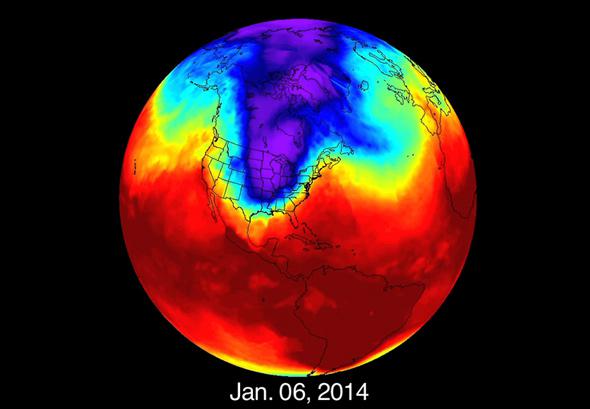Over the past year or so, I’ve written a few times on how the “polar vortex”—actually, deep meanders or excursions in the usually stable west-to-east direction of the polar cyclonic air stream—may be tied to global warming, but there hadn’t been enough research done yet to be sure.
Well, here we go: A team of Korean and American scientists has made the connection. Warmer waters lead to more melting of Arctic ice, which destabilizes the polar jet stream. My Slate colleague Eric Holthaus has an excellent write-up of it, and I wanted to give him a signal boost here. Go read it.
I want to add a few points. One I already made above: What people have been calling the “polar vortex” is not really the polar vortex. There is a stable flow of air (that’s the polar vortex) going around the poles, at higher latitudes than the jet stream. Technically a cyclone, it wanders and wiggles from a perfect circle, but sometimes will have deep excursions, bringing frigid Arctic air to lower latitudes. Those excursions are what hit the U.S. several times in the past year.
When this happens, the excursions can become somewhat stable themselves. This prevents the normal circulation of air around the globe, so they’re called “blocking patterns.” That’s what was responsible for the tremendous heat wave Alaska suffered in January 2014. Over a year ago, in June 2013, Alaska had a persistent high pressure system squat over the state, and the year before that a similar system caused a massive melting in Greenland.
I mentioned at the time the idea that global warming may be affecting weather patterns, and of course the denial Noise Machine kicked into gear; I got a lot of comments and tweets mocking the idea.
Now, though, we have this new research upholding that conclusion. I’m not surprised. We know that global weather patterns depend on a lot of factors, but the amount of available heat—thinking of it as fuel might help—is a critical one. If you crank up the planet’s thermostat you don’t just make the climate hotter, you make it unstable.
It’s like driving a car. A lot of factors have to balance for a safe drive: how much gas you give the engine, friction with the road, road surface conditions, weather, and so on. Step on the gas and you don’t just go faster; all those factors play in, and it gets harder to control the vehicle. A small gust, a slick patch of highway, a pothole—their effects all get amplified. When you hit the gas too hard you’re in for a very terrifying out-of-control ride.
And here we are, pedal to the metal.
The result? Extreme weather is becoming the new normal, with droughts in some places, flooding in others, strengthening tropical cyclones on the Atlantic, loss of polar ice, oceans acidifying, and more.
So while the Mail Online and Wall Street Journal continue to post ridiculous denier talking points, the world continues to heat up. I’ll note that the U.S. has done almost nothing about this, and that is almost entirely due to Republicans in the House and Senate. I’ll also note we have an election coming up, a very important one. Get the facts (I suggest starting here and here), and keep them in mind when you hit the polling booth this November.
